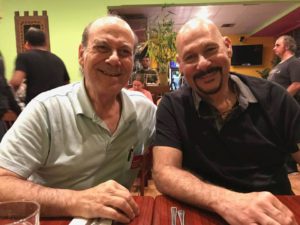The Bramson Archive Gets Larger and Larger
[AdSense-A]
As we wrote about last time, the collecting continued unabated throughout high school and eventually the collection took over our former back porch in the house on Cecil Street, that becoming “the railroad room.” More on that later.
Finishing Miami Beach High I elected, unlike so many of my classmates, to join dear friend and fellow swimmer Charlie Clark at FSU. (I wasn’t sure what I wanted to study and Charlie and I wanted a school with a great swimming program and so, with Bim Stults, a member of the swimming hall of fame as the coach, we elected to go to Tallahassee. It was there, without a car, that I would regularly walk the mile or so to the Seaboard Air Line Railroad station to photograph the facilities as well as the locomotives and the freight and passenger cars. Without going into excruciating detail, and even though my swimming talents improved under Stults, FSU was not for me. (As I liked to say at the time, “you can’t even get a bagel in this town.” And you couldn’t!)
I transferred to the U of Miami immediately and at the same time (December of ’62) I went right to work at the Fontainebleau. During the first couple of months I was a cabana boy but shortly thereafter the hotel’s Director of Entertainment, Ziggy Lane, asked me to become a teen age counselor and only about three months later named me head counselor. (Here I was, at 19, the head counselor at the Fontainebleau. It was like letting the fox loose in the hen house and more on that later, also!)
In December of ’62 I came back to Miami and immediately, when I wasn’t working, spent as much time as I could at the FEC, becoming a “familiar face” at the downtown ticket office, the station at 200 Northwest 1st Avenue and Buena Vista Yard. It was right at that time that events began to unfold that would enlarge my presence at the FEC as well as at the Fontainebleau while, of course, attending UM.
In 1961 the nation’s non-operating unions (non-ops) announced that it was time for their new contracts and they were demanding a 10.62 cent an hour wage increase for the employees in those crafts, which included many of the employees who did not actually operate the trains. While the story goes on for some years, suffice to say that, on January 22, 1963, after 32 meetings between FEC’s management and the unions, and with the unions refusing to accept offers that differed from the national settlement, the non-ops walked off the job. The operating unions—the men (no women at the time) who actually operated the trains—did not go on strike but refused to cross the picket lines and not a wheel moved on the FEC until February 10, 1963, when the first freight train, operated by supervisory personnel, ran from Jacksonville to Miami.
Eventually, it became evident that the strike would not be settled and the FEC began hiring new employees who were willing to cross the picket lines. Because of my relationship with the railroad, I became (as I am today, being the only person in the country who bears the official title of Company Historian with an American railroad) “number one in a field of one,” the only “railroad buff” who was allowed on Company property during the strike. We will continue in that vein next column, dear readers, but will also note that, all during that time I was still taking classes at UM, was on the swimming team there (Charlie finished the year at 1/2SU and joined me at UM in September of ’63), was working at the Fontainebleau, dating so many lovely young women who I met there, and, of course, continuing to build the collection that today is known as The Bramson Archive I was managing to enjoy life to the fullest, other than the fact that I was building up a great dislike for UM, as I did at 1/2SU.
Stay riveted, thought, folks, and we’ll see you (or write to you!) next time.
[si-contact-form form=’2′]


